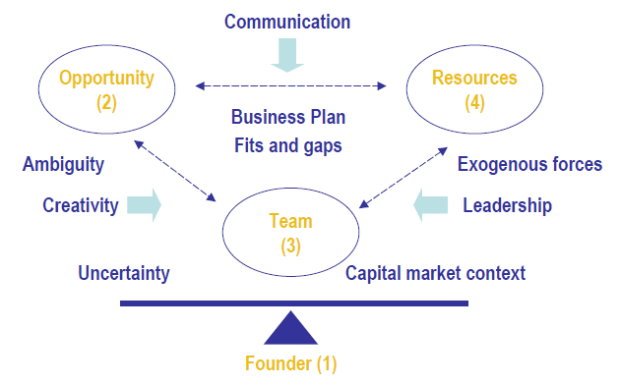The Timmons Model of Entrepreneurship considers opportunities, teams, and resources as the three critical factors available to an entrepreneur and holds that success depends on the ability of the entrepreneur to balance these critical factors.
The entrepreneur searches for an opportunity, and on finding it, shapes the opportunity into a high-potential venture by drawing up a team and gathering the required resources to start a business that capitalizes on the opportunity. the entrepreneur risks his or her career, personal cash flow and net worth.
Change the Odds: Fix It, Shape It, and Mold It
The process starts with opportunity, not money, not strategy, not networks, not the team, not the business plan. Most genuine opportunities are much bigger than either the talent and capacity of the team or the resources available to the team at the outset. The business plan provides the language and code for communicating the quality of the three driving forces and of their fit and balance.
The components of the Timmons model are in constant motion, expanding and contracting as the environment and opportunity change. We begin with an overview of entrepreneurship as process followed by a description of each component in the Timmons model. Teaching entrepreneurship as a rigorous course of study demands the conversion of scholarly research into applied frameworks that can be understood at all levels of education and application. Entrepreneurship education seeks to minimize the risk of venture failure when exploiting new opportunities in the marketplace and the Timmons model reflects the delicate balance of opportunities, resources, and entrepreneurs responsible for execution.
The Opportunity Factor
Timmons model dictates that the entrepreneurial process does not start with business plan, money, strategy, networks or team. The Timmons model believes strongly that entrepreneurship is nothing but opportunity driven. Opportunities are more essential than the talent or competence of lead entrepreneur and the team because a right opportunity identified ensures long- term success of the business. A good idea does not necessarily bring about a great business. An excellent idea is found when product or services could be positioned to create or add values to customer, remains attractive, durable and timely.
The two major roles of the team, relative to the other critical factors are:
- Removing the ambiguity and uncertainty of the opportunity by applying creativity.
- Providing leadership to manage the available resources in the most effective manner by interacting with exogenous forces and the capital market context that keeps changing constantly.
The Resources Factor
The Timmons model discounts the popular notion than extensive resources reduce the risk of starting a venture and encourages bootstrapping or starting with the bare minimal requirements as a way to attain competitive advantages. The advantages of bootstrapping include:
- Driving down market cost
- Instilling discipline and leanness in the organization
- Encouraging creative resources to achieve more with the limited amount of money and other resources available.
The entrepreneur works to “minimize and control” rather than “maximize and own.” The role of the entrepreneur in managing the resources include building a good resource base to draw from when required and drawing up a business plan through a “fit and balance” method that balances the available resource with the opportunity and the potential of the team.
The Team Factor
A highly effective lead entrepreneur should be able to put the best talent together after identifying the opportunity and gathering required resources. The sizes and the background of the team are contingent upon the size and nature of opportunity. According to Timmons model, a good team can lead to great success and a badly formed team can waste great idea which is disaster to any form of business. Among all resource, only a good team can unlock a high potential with any opportunity and manage the pressure related to growth.
The two major roles of the team, relative to the other critical factors are:
- Removing the ambiguity and uncertainty of the opportunity by applying creativity.
- Providing leadership to manage the available resources in the most effective manner by interacting with exogenous forces and the capital market context that keeps changing constantly.


